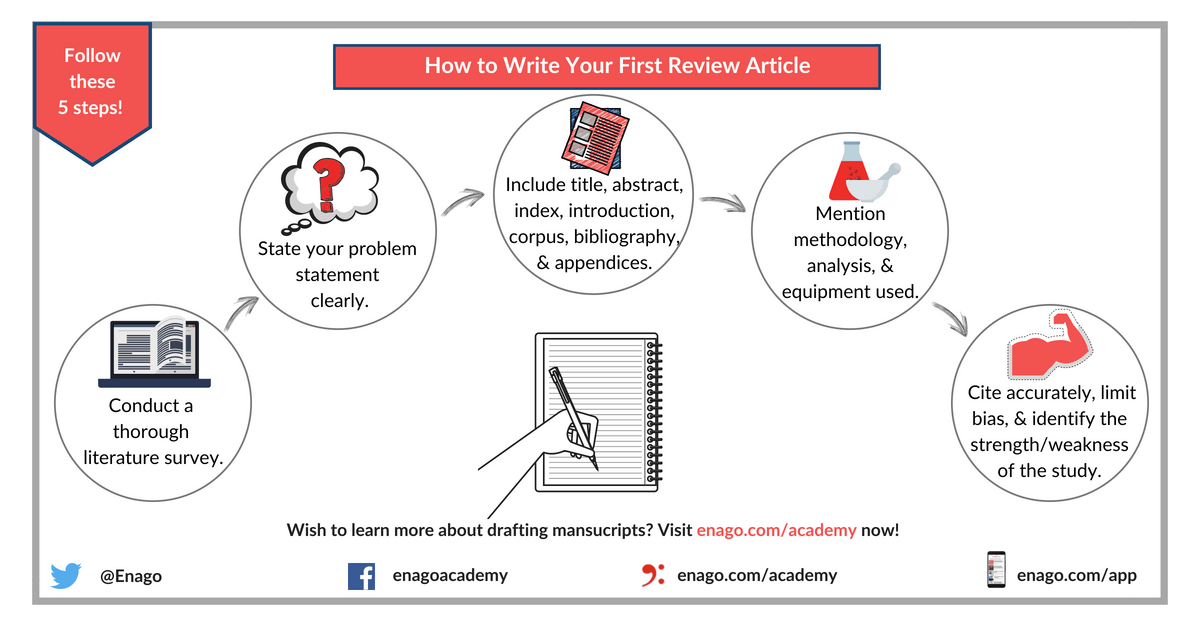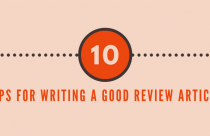How to Write a Scientific Review Article

In the biosciences, review articles written by researchers are valuable tools for those looking for a synopsis of several research studies in one place without having to spend time finding the research and results themselves. A well-presented review paper provides the reader with unbiased information on studies within the discipline and presents why the results of some research studies are or are not valid. In addition, institutions that fund research tend to use review articles to help them decide whether further research is necessary; however, their value is only as good as the objectives achieved and how the results are communicated.
The objective of a review should be “to achieve an organization and synthesis of past work around the chosen theme in order to accelerate the accumulation and assimilation of recent knowledge into the existing body of knowledge.” Importantly, a review should present results clearly and accurately—good writing is essential and must follow a strict set of rules.
In 1996, Quality of Reporting of Meta-analyses (QUOROM), which focused on meta-analyses of randomized controlled studies, was created during a conference involving a group of scientists, clinicians, and statisticians. The QUOROM statement, checklist, and flow diagram were introduced to researchers to help them better organize their reviews and ensure that specific criteria were followed. QUOROM was later updated and renamed Preferred Reporting Items for Systematic Reviews and Meta-Analyses (PRISMA) with the same values and criteria.
Types of Review Articles
A review article is not an original study. It examines previous studies and compiles their data and evidence.
Based on their structure and formulation, literature reviews are broadly classified as-
- Narrative or Traditional Literature Reviews
– This is the classic literature review that summarizes the collated literature relevant to the thesis body. - Scoping Reviews
– Scoping reviews involves systematic searching of all the material on the topic and replicate your searches. This enables the researcher to fill in any gaps that appear in results. - Systematic Literature Reviews
– It is a methodical approach to collate and synthesize all relevant data about a predefined research question. - Cochrane Reviews
– These are internationally recognized systematic reviews for human health care and policy.
Although narrative reviews can be useful, they are not in depth and do not necessarily analyze data or study-group sizes for determining whether results are valid. Systematic reviews, on the other hand, are more detailed and involve a more comprehensive literature search—they are the “gold standard” of review articles. A meta-analysis is a quantitative systematic review. It combines data from several studies to reach a conclusion that is statistically stronger than any in the single studies, mainly because of having more study subjects and more diversity among subjects.
A good review usually concentrates on a theme, such as different theories, information on the progress of developing a new medical device, or how past developments influence new discoveries. A review might also ask that more resources be used to continue research in that specific field.
There are advantages and disadvantages to writing a review. In addition to having more available data, other advantages include confirmatory data analysis and that reviews are considered to be an evidence-based resource. Some of the disadvantages are they are more time consuming and not all studies will provide the requisite amount of data. In addition, statistical functions and interpretations are more complex and authors must ensure that the populations from each study and all studies combined are heterogeneous.
Literature Searches
Previous reviews on the chosen theme using Google Scholar can provide information on any new findings, and the following points should be considered when conducting searches:
- The author and any possible conflicting interests
- The purpose of the article
- The author’s hypothesis and whether it is supported
- How the literature will contribute to your topic
- Whether opinions expressed by the author(s) are correct
Once the inclusion and exclusion criteria have been identified based on these points, authors are ready to prepare their paper. Sources such as Popular Science and WebMD.com should be avoided. These sources, among others, are not allowed to be used as sources for review articles. Authors must ensure that the sources are legitimate research studies and that they are similar in nature (e.g., all randomized controlled trials).
Manuscript Preparation
Maximum length can vary depending on the author guidelines from the journal to which you are submitting, so authors must always check those guidelines before they begin. As a general rule, most journals ask that a specific font and size be used (e.g., Times New Roman, 12 point), that 1.0-inch margins be used on all four sides, and 1.5 line spacing be used.
The article structure should contain very specific sections, which might vary slightly according to different science disciplines. In scientific writing, the IMRAD structure (introduction, methods, results, and discussion) is a standard format adopted by a majority of academic journals. Although specific author guidelines might vary, in most cases, the review paper should contain the following sections:
Title page
- Main title (possibly, short title)
- Zurich-Basel Plant Science Center suggests providing titles which are 8 to 12 words in length
- The title must contain key elements of the subject matter.
- Author names and affiliations should be included
- Corresponding author details should be mentioned
Abstract
- Main points, or a synthesis, of the project should be outlined
- Subheadings should be included if required (e.g., objective, methods, results, and conclusions)
- The length of the abstract should be between 200 and 250 words
- No citations included within the abstract
- Acronyms and abbreviations should be included only if used more than once
Introduction
- Background information on the topic should be discussed
- Introduction must address the objective (research question)
- Text should be written in present tense
Materials and Methods
- Should be written in past tense
- Should provide information necessary to repeat the review
- Search strategies, inclusion and exclusion criteria, data sources and geographical information, characteristics of study subjects, and statistical analyses used should be included
Results
- Authors must include all the results
- Their relevance to the objective should be mentioned
- Results must include heterogeneity of the study groups or samples
- Statistical significance should be mentioned
Discussion
- Background information and objective can be reiterated
- Results and their relevance clearly and concisely discussed
Conclusions
- This section should discuss the objective discussed in the introduction This section should discuss the implications of the findings, interpretations, and identify unresolved questions
Study Limitations
- An assessment of whether the studies were adequate to reach a conclusion that can be applied to a much larger group, stating reasons
- Suggestions for future studies should be provided
Acknowledgements
- Authors may thank the people or institutions who have supported the work
References
- Only those references cited in the text should be listed
- 50 to 100 references are allowed
- Internet sources are usually not allowed










Very informative and helped in me understanding the do and donts of writing a review…. A big motivational and knowledgeable article for those qho want to get motivation to begin the process of ones thought into practical work and take the first stwp in this regard